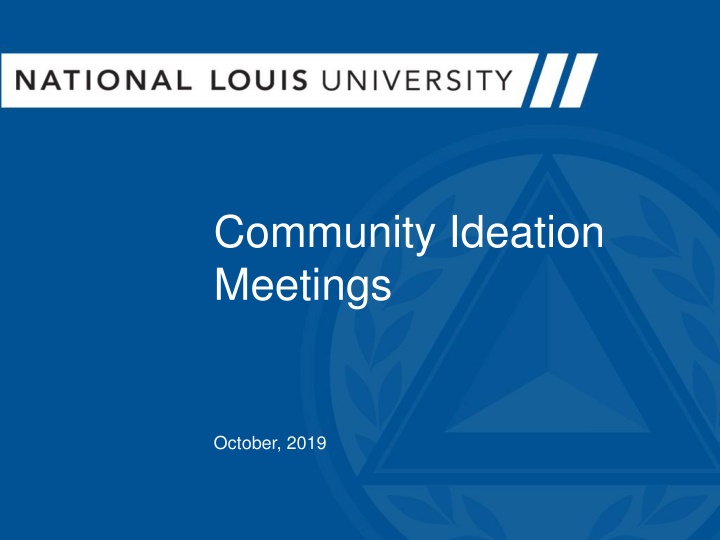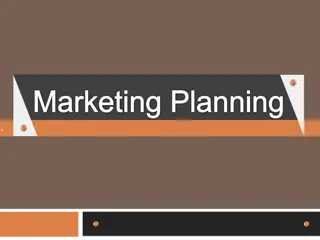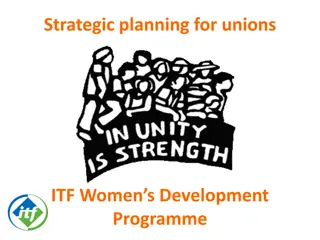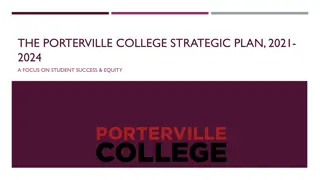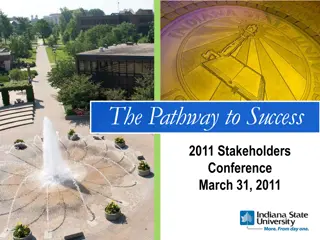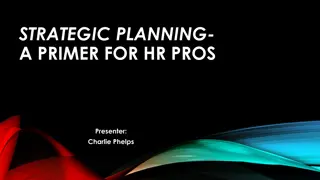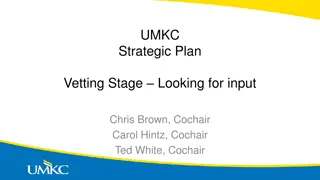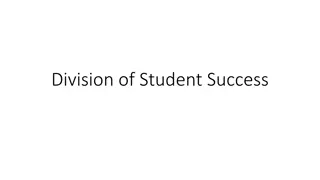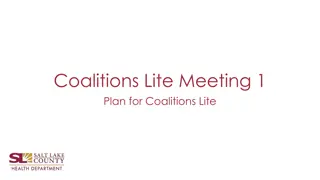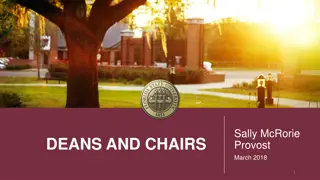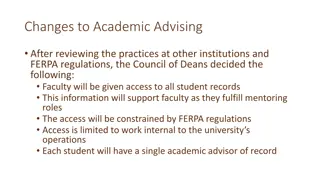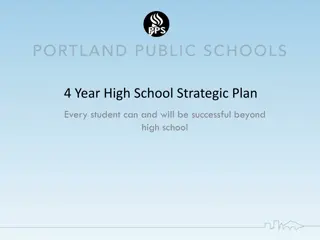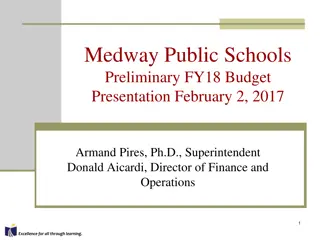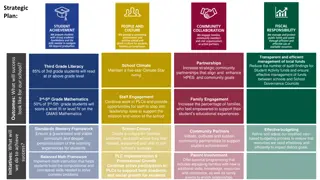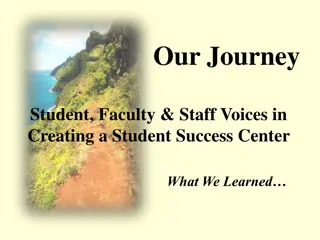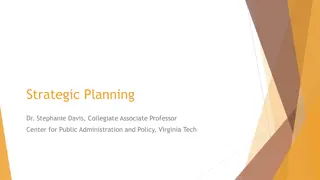Strategic Planning for Enhanced Student Success and Community Impact
Engage in a comprehensive strategic planning process to align curricula, enhance student support, and embody values of diversity and inclusion for long-term success. Through internal input refinement and action pillars, focus on career-aligned instruction, exceptional student services, and fostering a collaborative educational journey. Embrace a forward-thinking approach to future-proof the university and empower students for civic engagement and professional achievement.
Uploaded on Aug 24, 2024 | 3 Views
Download Presentation

Please find below an Image/Link to download the presentation.
The content on the website is provided AS IS for your information and personal use only. It may not be sold, licensed, or shared on other websites without obtaining consent from the author.If you encounter any issues during the download, it is possible that the publisher has removed the file from their server.
You are allowed to download the files provided on this website for personal or commercial use, subject to the condition that they are used lawfully. All files are the property of their respective owners.
The content on the website is provided AS IS for your information and personal use only. It may not be sold, licensed, or shared on other websites without obtaining consent from the author.
E N D
Presentation Transcript
Community Ideation Meetings October, 2019
STRATEGIC PLANNING TIMELINE Mission, Vision & Values Review May 2019 Dec 2019 Internal & External Environmental Scan; Community Ideation July 2019 Dec 2019 Board Retreat; Strategy Development; Plan Drafted Dec 2019 Mar 2020 Plan Finalized; Board Approval Mar 2020 June 2020 Communication, Training, & Implementation Planning June 2020 Dec 2020 2
CONVERTING INTERNAL INPUT INTO A PLANNING FRAME 3 Strengths Challenges Identity Refinement into a frame for building a plan
BROAD PILLARS FOR ACTION 4 Mission and Career-Aligned Curricula and Instructional Delivery Exceptional Student Support Living our Values of Diversity, Equity, and Inclusion Embodying our Teaching One University Identity Future-Proofing the University
PILLAR 1: MISSION AND CAREER-ALIGNED CURRICULA AND INSTRUCTIONAL DELIVERY 5 Why is this important? To insure that all individuals have the opportunity to be civically-engaged and competitively prepared for career and professional success, we must align student learning with employment needs and the development of civic mindedness. We must be at the frontier, developing new models of how, when, and what kinds of knowledge and skills are taught in the 21stCentury. This will require talented faculty, staff, and strong partnerships with external stakeholders to ensure our students are successful and ultimately prepared to have a positive impact on their communities.
PILLAR 2: EXCEPTIONAL STUDENT SUPPORT 6 Why is this important? What differentiates us from other institutions is our commitment to being partners with our students during their educational journey. This partnership demands that we deliver on exceptional and seamless service for students so their sole focus is on their growth and development as a professional. We recognize that this involves commitment and collaboration from all institutional stakeholders from supporting prospective students, to retaining and helping students to be academically, and socially successful, to helping them advance their careers and impact their communities. We collectively work to understand the expectations, aspirations, and barriers faced by our diverse student body so that we can deliver an exceptional educational experience for all.
PILLAR 3: LIVING OUR VALUES OF DIVERSITY, EQUITY, AND INCLUSION 7 Why is this important? We are committed to supporting a diverse professional work force and removing educational barriers to social and economic mobility that disproportionately affect non-majority students. All members of our community should feel respected, valued, and deserve to be in an environment that brings out their full potential. We also know that truly embodying our DEI values will result in a stronger institution, able to benefit from the full range of talent, knowledge, and cultural capital that comes from a diverse inclusive community. Finally, along with our graduates, we have greater capacity to generate long-term impact on communities beyond NLU if we embody DEI values.
PILLAR 4: EMBODYING OUR TEACHING ONE UNIVERSITY IDENTITY 8 Why is this important? We have always been and have always prided ourselves on being a teaching institution. We recognize that you cannot be teaching-focused without being student-focused. Accordingly, we are focused on the recruitment, development, retention, and reward of an exceptional and diverse faculty community. The evolving way that students learn requires us to be leaders in pedagogical thinking, embrace technology-enhanced delivery models, and support faculty development in relation to the most effective teaching methods. We will leverage the scholarship of faculty as well as learning outcome data to help champion the changes needed in teaching and learning to ensure student success, and to further solidify our reputation as a leader in delivering powerful results for our students.
PILLAR 5: FUTURE-PROOFING THE UNIVERSITY 9 Why is this important? In order to continue our work and fulfill our mission, we must ensure that our fiscal circumstance is strong and our operational structures are efficient and able to sustain us across time. We must take calculated risks, be nimble, and be willing to change to address the interests and needs of students and the organizations and communities in which they work and live. To be successful in this area, we must continue to ensure we have the right talent in the right positions, and build new competencies where needed. We must also continue to elevate public recognition of the institution and demonstrate our social and economic impact so that we are attractive to students, engaged and respected by alumni, and funders, and other important stakeholders.
DIRECTIONS 10 Choose the pillars you are most interested in. You may respond to as many or as few as you wish. Then respond to those pillars with ideas about any or all of the following questions: What major outcomes should we expect in the next 5-10 years? How do we achieve our major outcomes? Use a (TEAL) post-it note to contribute thoughts about actions within each pillar we might need to take to achieve those outcomes? What barriers should we be aware of and proactively address? Use a (PINK) post-it note to identify barriers that may negatively impact our actions. How will we know we succeeded? Use a (YELLOW) post-it note to provide suggestions about how we might measure our success within a pillar.
11 Questions? Concerns? Ideas?
APPENDIX: 18 THEMES FROM ANALYSIS OF FEEDBACK TO DATE 12 Commitment to DEI A culture of adaptability and innovation Remaining committed to access Meeting student needs and removing barriers Community, partner and civically engaged institution Committed to advancing economic and social equity Having the talent we need to do the work Adapting our offerings to meet changing needs Building institutional reputation Building pride through evidence of excellence Leveraging our urban presence Ensuring students are ready for their professional field Diverse student body (including international students) Expand impact through growth Financial sustainability for the Institution Investing in our faculty Operational efficiency Infrastructure capable of sustaining growth
